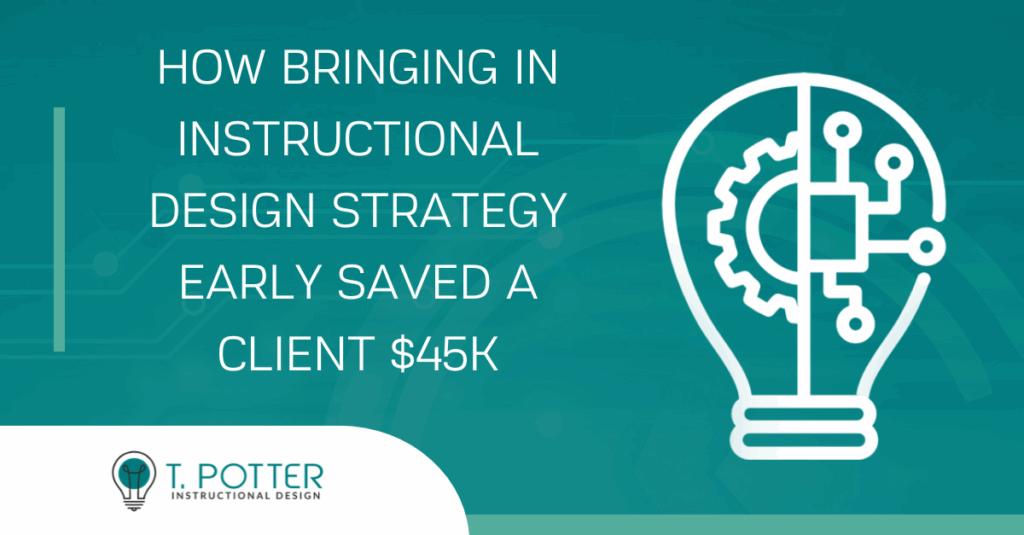(And Made Their Training More Effective)
When most people think about hiring an instructional designer or a Fractional Chief Learning Officer (CLO), they think of it as a later step.
After the goals are set.
After the grant is written, approved, and you’re already a year into the project. You know, when you’re finally ready to start making all the stuff that you’ve been planning.
But by this point, so much has already been done that it’s nearly impossible to untangle what’s already happened, especially if what’s been written or recorded isn’t working.
But here’s the truth:
Bringing instructional designers in earlier doesn’t just make training better; it saves you real money.
Let’s look at an example
The Original Plan: Big, Bold, but a Little Backwards
Last year, an organization that creates professional development approached us with a bold vision:
A fully updated, two-week professional development program for managers. It would be delivered in person, supported by all new materials, assessments, and facilitator guides.
They were planning to invest $120,000 in the project.
The structure was already scoped, they knew who their internal stakeholders would be, and the expectations for time, format, and deliverables were all based on what they’d done in the past.
But this time, something was different:
They brought us in before finalizing the plan.
The Strategic Reset: Start With Outcomes, Not Hours
Rather than jumping straight into content or tech, we started with a core question:
“What do learners actually need to be able to do by the end of this?”
Once we defined the outcomes, the rest became clearer—and leaner.
We realized:
- Some content was duplicated across multiple modules
- Certain “nice-to-haves” were inflating the cost without adding impact
- We needed to make sure we were leaving space for the facilitators to share their own stories (but not go off the rails)
With those insights, we rebuilt the plan from the ground up:
- Cut the overall training hours by 30%, reducing both development costs and making it more appealing to learners
- Recommended media development strategies that allowed for polished slides and handouts with lower production costs
- Proposed a phased development structure to hit their desired rollout schedule
The Result: A Leaner, Smarter, More Effective Program
The final proposal? $75,000.
A full $45K less than originally scoped.
What we designed made not only this project cheaper, but it also made every other project they did in the future cheaper, too!
Because we reevaluated the state of their training development processes based on current learner needs, we created a model that could be replicated for all their other training in the future as well. We got them out of the mindset of “we’ve always developed it this one way” and found opportunities that could be practiced in all their other training programs.
We are doing this right now with their next project, which, again, was estimated to be 30% under budget compared to what they would have paid using their previous processes.
Why This Matters for Professional Development Organizations
If you’re leading an organization that provides professional development, then your people are likely facing big shifts—new roles, new skills, new standards, and big pressures. You need training that works, and you probably need it fast.
But fast doesn’t mean sloppy. And effective doesn’t have to mean expensive.
Bringing in the instructional designers early:
- Helps you right-size your training
- Aligns learning goals with your business outcomes
- Saves you from wasting time and money on the wrong things
- Makes your team look sharp, intentional, and future-ready
And yes, sometimes it cuts the project budget by nearly half.
Planning a Training Program? Let’s Talk First.
We’ve created a free FAQ about what it is like working with us to help you get started. You can download it here.
Or if you already know you’ve got a big project coming up, bring us in early. It might be the best decision you make this year.
Book a strategy call here.
Let’s make your next training faster, smarter, and a whole lot easier.

Teresa Potter, M.Ed., specializes in strategic projects that drive measurable results while finding creative solutions. Her organization, T. Potter Instructional Design (TPID), partners with subject matter exports to make training development easy. TPID works with associations, nonprofits, and educational institutions across industries like healthcare, human services, leadership, and AI in education. Their goal is to empower experts to do more of what they do well through the capabilities of teaching and learning science.


